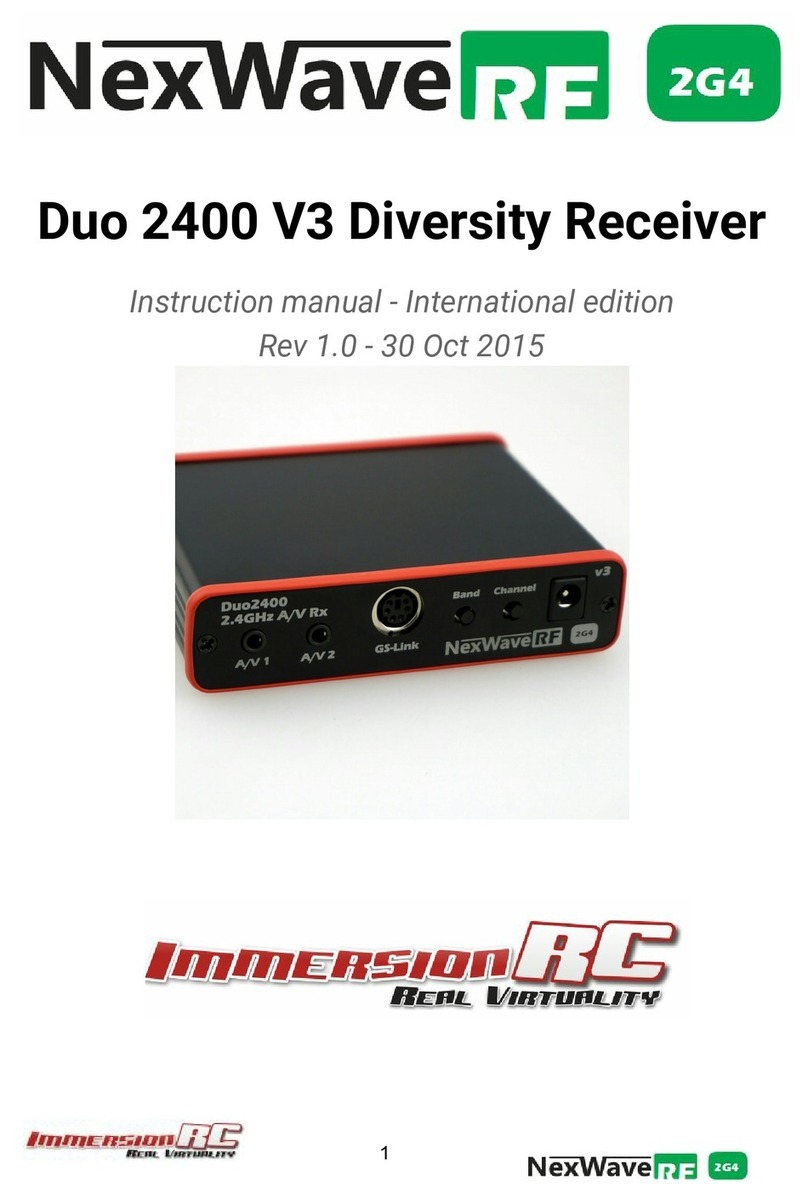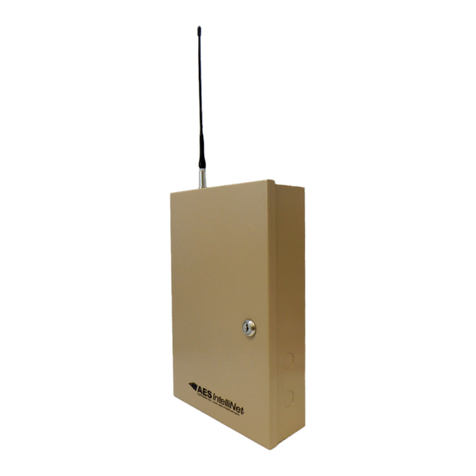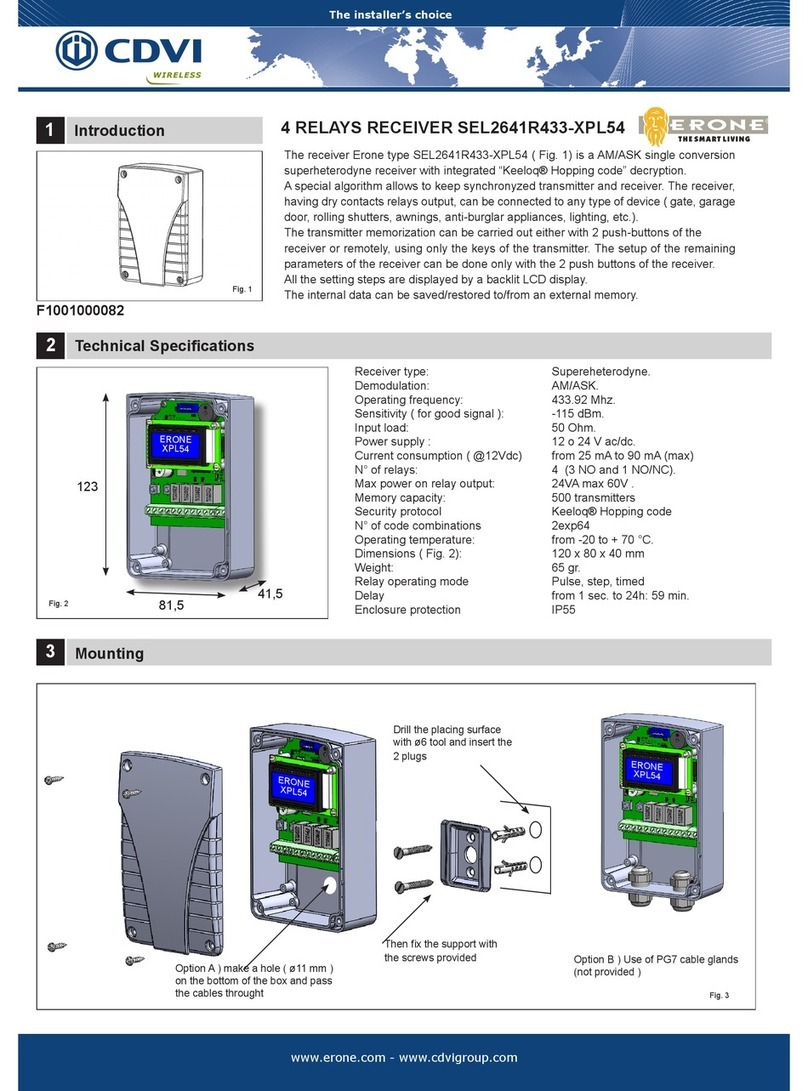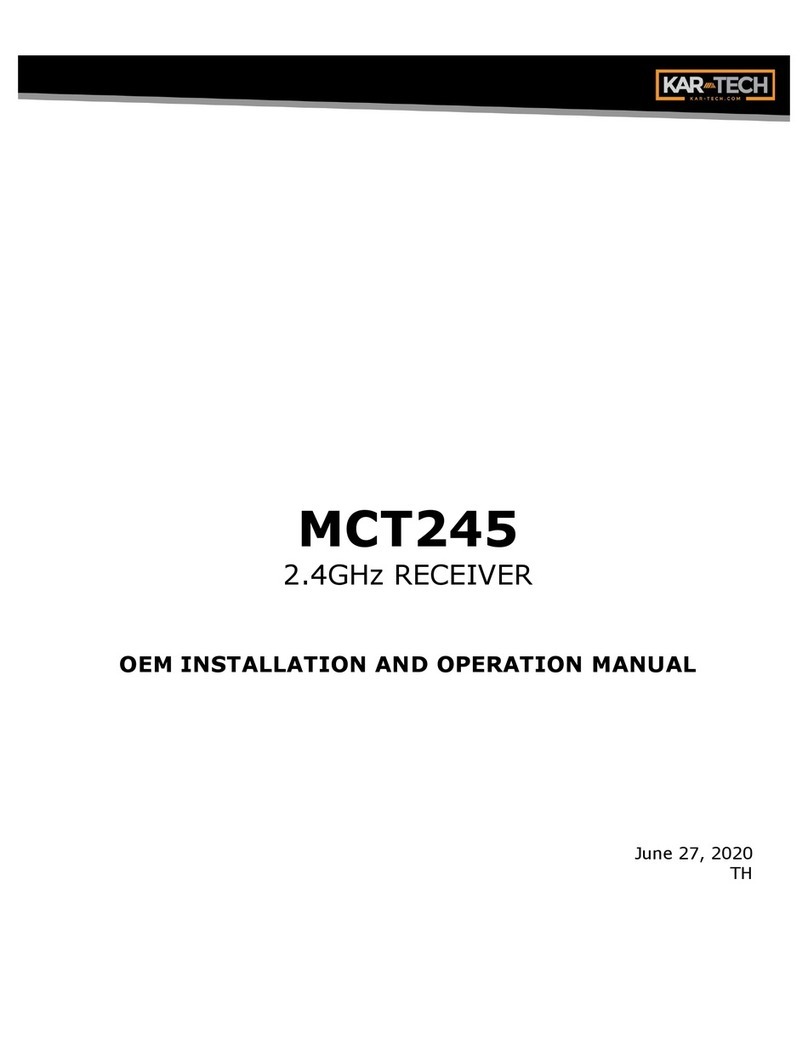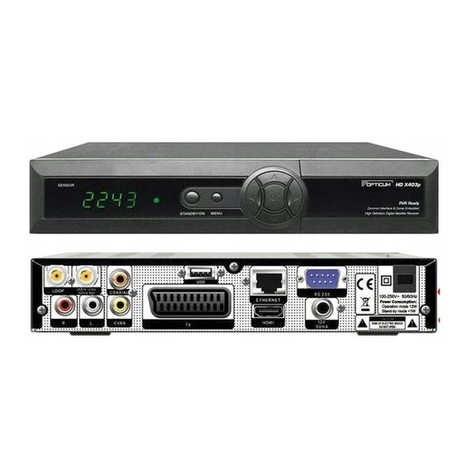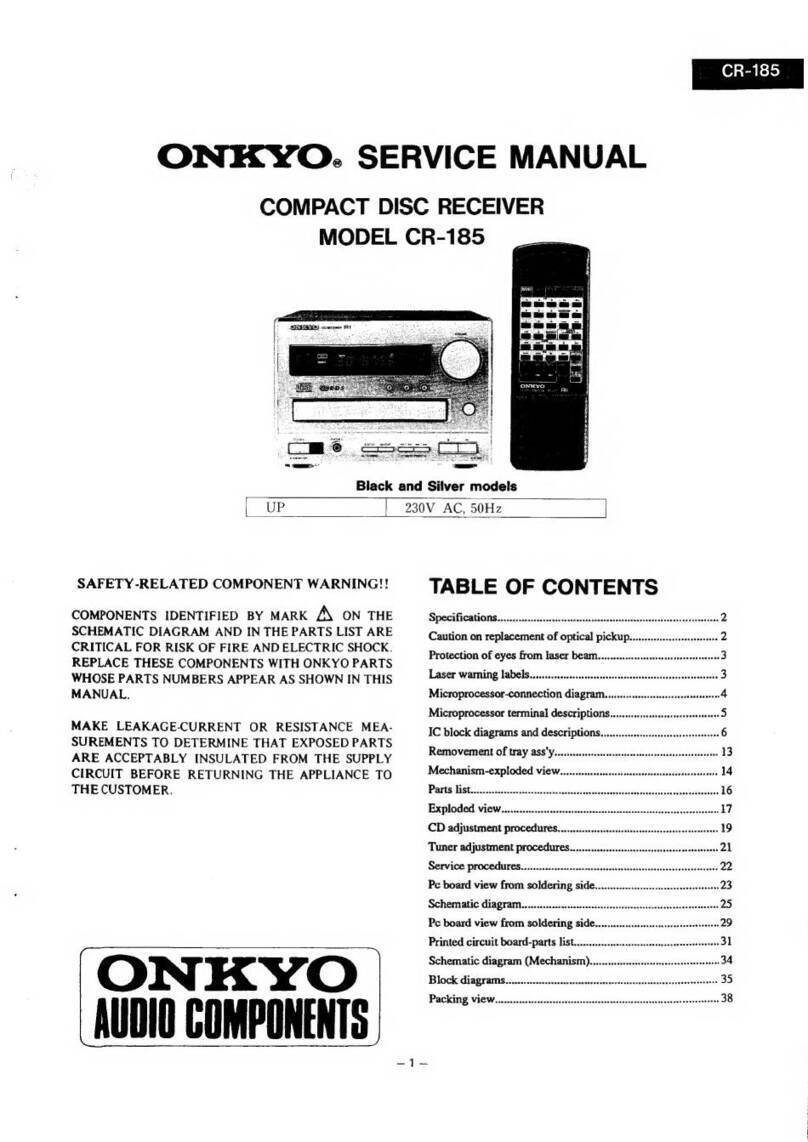ImmersionRC Duo 5800 User manual

Duo 5800 Diversity Receiver
Twin receivers for best reception
Conventional receivers have one big drawback, they only allow for a single
antenna to be connected. If for some reason the reception fails there’s no
backup and you lose the signal. Not so with the Duo 5800 diversity
receiver. With its twin receivers it allows you to hook up two antennas
and the microcontroller inside will automatically switch to the receiver
with the strongest signal, without any switching noise or a change in the
image received.
With -85dB sensitivity per receiver the Duo 5800 is sensitive, very
sensitive. Paired with two flat patch antennas it will give you many
miles/kilometers of range. It is engineered from an FPV-er’s perspective
and hence has features to match. It’ll warn you when the receiver battery
runs low, or when switching antennas. The diversity receiver works best
with either a 2S or 3S LiPo battery and the low voltage warning can be set
accordingly, either automatically, or user configurable.
Equipped with two buffered AV outputs it allows you to connect your
goggles, as well as your recording device, without the need for Y-cables or
a signal splitter. Operating the Duo 5800 Diversity Receiver couldn’t be
simpler. After applying power it’ll beep the number of LiPo cells it has
detected and sets the low voltage warning to match. Selecting channels is
a breeze; four channels according to the frequencies used by Airwave and
another six as used by Lawmate are available with the press of a button.
ImmersionRC –Real Virtuality
.
Twin receivers for best reception.
Standard 5.8GHz band
frequencies: 5740MHz, 5760MHz,
5780MHz, 5800MHz, 5820MHz,
5840MHz, 5860MHz
Automatic antenna switching.
Calibrated receivers for seamless
switching between antennas
Dual, buffered AV outputs
Automatic of user configurable
low battery alarm
Can be powered from 6-13V (< 9v,
or 2s recommended)
High bandwidth stereo-audio.
Single button operation for
channel selection
Visual indication of selected
antenna
Twin female SMA antenna
connectors
FM Audio/Video Modulation
-85dB typical sensitivity
50 ohm antenna impedance
1Vpp Video output level
3V pp Audio output Level
Small, light weight, durable,
anodized aluminum casing
Weight: 169-grams
Size : 103 x 90 x 23mm

Operating the Duo 5800 Diversity Receiver
Operating the receiver is simple, as a single push-button allows for switching channels as well as setting
up user configurable settings. After applying power, and provided the ‘auto’ setting for the low voltage
warning is selected, it’ll beep the number of LiPo cells it has detected. So two beeps is a 2S LiPo and the
low voltage warning is set to 6V, three beeps is a 3S LiPo and the low voltage warning is set to 9V.
The Duo 5800 Diversity Receiver can tune to 7 channels in the 5.8GHz ISM band, these are frequencies
used by much of the existing 5.8GHz FPV equipment on the market, ensuring compatibility.
It will cycle through the 7 channels each time the button is pressed, with the last chosen channel stored
to be used when next powered up.
When the low voltage battery alarm is triggered the receiver will start to beep indicating you need to
charge or change the battery. Furthermore it’ll also beep when the input voltage is too low, less than 5V
or too high, more than 13V. At voltages less than 5V it will not work reliably, at voltages over 12V it will
run hot over a longer period of use, so this is not recommended. The power input is reverse polarity
protected; however it is good practice to always check polarity prior to applying power. The Duo 5800
diversity receiver power connector is center pin positive, which seems to be the norm.
Programming the Duo 5800 Diversity Receiver
The Duo 5800 Diversity Receiver can be configured to store user selected configuration settings. The
selected channel will always be stored so at power up it defaults to the last selected channel. Other
settings that can be configured are:
Low voltage alarm threshold
Rx Switch Tick enable/disable
Programming these settings is accomplished by using the push button, with feedback from the internal
beeper, in a manner similar to that used by most ESCs (Electronic Speed Controllers).
To enter the programming menu, hold down the push button for 5 seconds or longer. Once the
programming menu has been activated, the receiver will start cycling through the menu options, in the
order listed.
To change one of the items, wait for it to be ‘played’, and immediately after, press the button.
The receiver will then ‘play’ the current value, as a number of beeps, and will then start from the first
option, and play each option until the last. Selecting an option is simply done by waiting for it to be
played and pressing the button briefly.

For example to change the Rx Switch Tick setting:
Button pressed for > 5 seconds
Dash Dot Dot Dot - third menu item –press button briefly to enter setting
Dot Dot - current setting
Dot - first available option - Tick Off press button briefly
At this point the Rx Switch Tick setting has been changed to ‘Tick Off’. The module will now continue
with the next item in the menu, and continue to the end of the list. Once the end of the list is reached,
the receiver will automatically exit the programming mode signaled by two short beeps.
Beep Codes
Beep Code
Menu
Menu Choices
- .
Low Batt Volts
1 –Auto (for 2S or 3S LiPo)*
2 –6v
3 –7v
4 –8v
5 –9v
6 –10v
7 –11v
8 –12v
Default: 6V for 2S, 9V for 3S
- . .
Low Batt 100mV
1 –0.0v …. 10 – 0.9v
Default: 0.5v (for threshold of 9.5v)
(Ignored in Auto mode)
- . . .
Rx Switch Tick
1 –Tick Off
2 –Tick On *
Note that * indicates the default value .

Rx-change Ticks
When the diversity receiver’s microcontroller switches receivers, it issues an audible ‘tick’. A useful
confidence-building feature when using the receiver, but if you feel the ticking becomes annoying you
have the option of turning it off.
Low Battery Volts
Low Battery 100mV
These two options can be combined to set the threshold at which the low-voltage alarm sounds.
In Auto mode (the default), the receiver will sense the attached battery voltage, and will set the alarm
voltage accordingly (6V for 2S and 9V for 3S LiPo). This mode is designed only for use with LiPo batteries.
For use with NiCD, NiMh, or other batteris, set the alarm voltage manually, for example:
9.2v set LowBattVolts to 5 (9v), and LowBatt100mV to 3 (0.2v)
10.0v set LowBattVolts to 6 (10v), and LowBatt100mV to 1 (0.0v)
When powering the receiver from LiPo batteries, it is important to note that the discharge curve is fairly
flat, and drops off quickly near the end. Setting a threshold of around 3.0/cell is relatively safe. It is
however highly recommended to perform a ‘dry-run’ after setting the voltage warning threshold to
make sure the low battery warning is set up correctly.
If upon connection of a battery pack the receiver beeps continuously then the low battery warning is set
higher than the voltage from the battery pack, so reset accordingly or charge the battery pack.
Note that regardless of the low battery alarm settings, a fixed alarm will occur when an input voltage
smaller than 5V or larger than 13V is detected. This safeguards the receiver from being used with input
voltages with which the correct operation cannot be guaranteed.
Safety Note: Even though this alarm will provide some protection against loss of video signal during an
FPV flight, it is highly recommended to fully charge all battery packs used before each and every flight.
Antenna Selection & Placement
The diversity receiver may be used with standard 5.8GHz antennas, equipped with a male SMA
connector. The spacing between the two antennas is fairly important, so as to avoid simultaneous nulls
received by both receivers simultaneously. 1 ½ wavelengths of separation, or approx. 18.4 cm (7.2 inch)
is suitable, but multitudes of that can be used also (36.8 cm, etc.).
Other ImmersionRC Receiver manuals
Popular Receiver manuals by other brands

Fairponte
Fairponte Ranger quick start guide
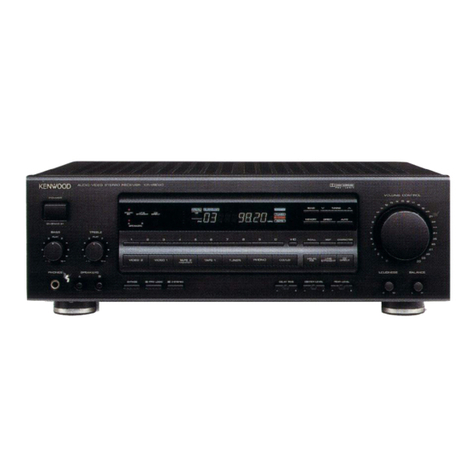
Kenwood
Kenwood KR-V8040 instruction manual

OmniCell Comunications
OmniCell Comunications FWT 335 user manual
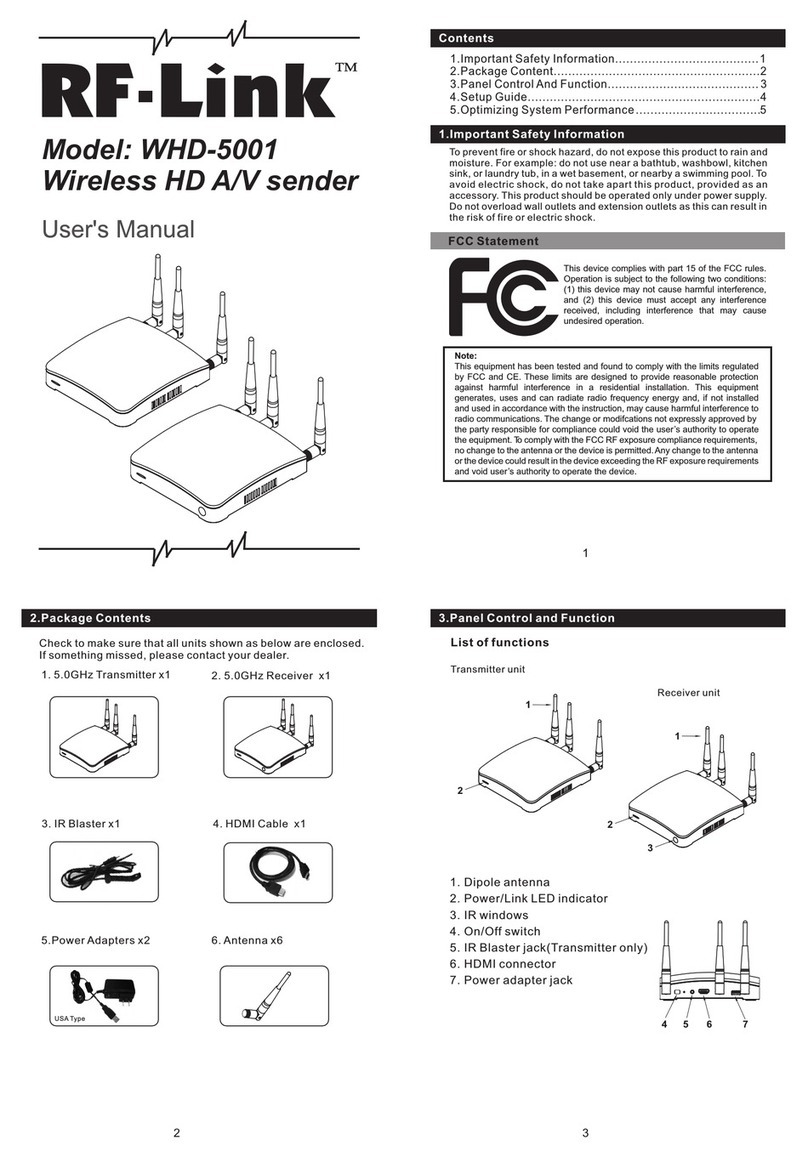
RF-Link
RF-Link WHD-5001 user manual
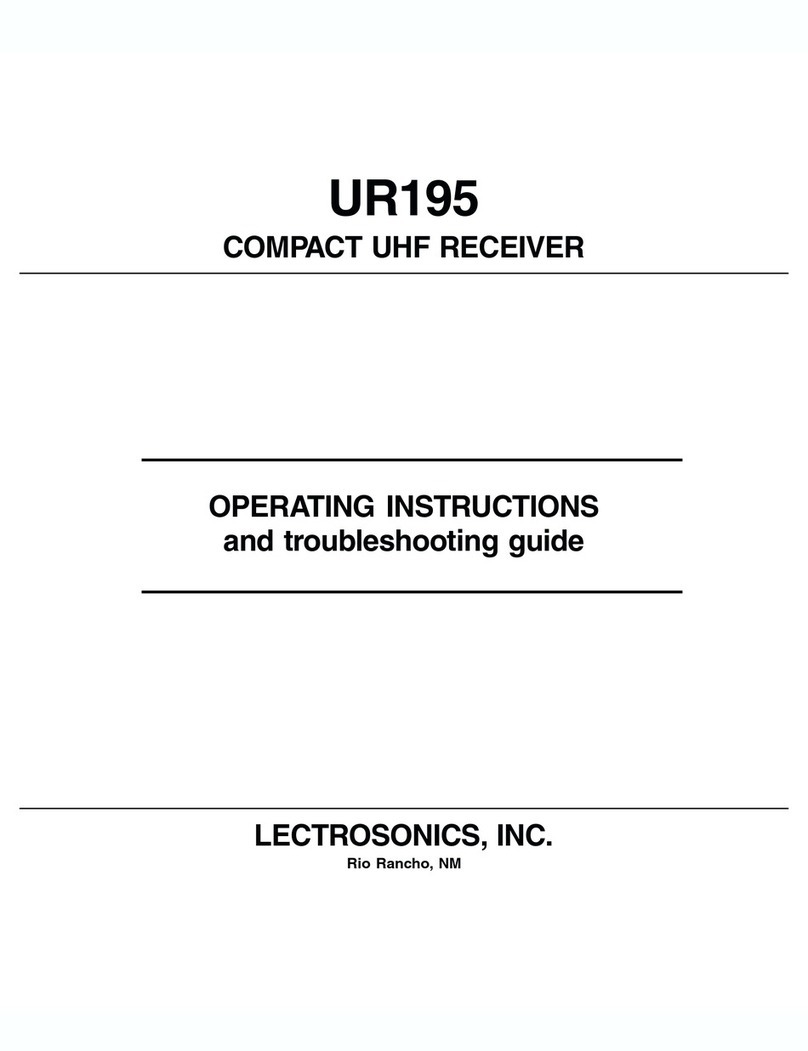
Lectrosonics
Lectrosonics UR195 Operating instructions and troubleshooting guide
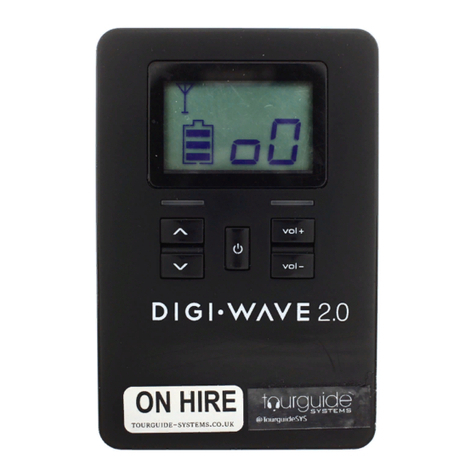
Williams Sound
Williams Sound DLR 60 2.0 Quick setup guide
